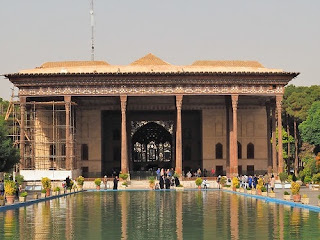*MS39 - more of the enchanting city of Isfahan, Iran*
Isfahan has such an old charm that I will give her a 2nd day to enchant the readers.
Near to the Square is this Chehel Sotoun Pavilion built more for the king to entertainment guests. It is surrounded by a huge garden, with many busts of Persian literary greats.
The entrance of the pavilion has 20 cedar columns. With another 20 reflected from the pool, it has 40. The pavilion is thus nicknamed the "Forty Columns" or "Chehel Sotoun".
Visited 2 famous old arch bridges in the evening. The Khaju Bridge, 133 m long was built around 1650. It served as a bridge and a weir. The Allahverdi Khan Bridge, 298 m long was built around 1600, on the old Silk Road route.
Besides the mosques, another equally beautiful religious building is the Vank Cathedral for the Armenian Christians, first built around the 1650s. It has a domed sanctuary, much like an Iranian mosque. The interior is elaborately decorated with frescoes and carvings/paintings. It is still in use today.
And lastly another type of building: pigeon towers. For centuries Isfahan relied on pigeon dropping to fertilise the city’s fields. To gather the dropping, special tower homes were built for the pigeons. The biggest could be 20 m in diameter and 20 m high, and could house up to 14,000 pigeons. The interior consists of endless nesting balconies in checkerboard honeycomb pattern scattered uniformly along the walls. They are like our 燕屋 in coastal Selangor.
With the advent of artificial fertilisers pigeon towers now number in t he low hundreds, no more in the thousands. We visited one dated to the 17th century.
Isfahan has such an old charm that I will give her a 2nd day to enchant the readers.
Near to the Square is this Chehel Sotoun Pavilion built more for the king to entertainment guests. It is surrounded by a huge garden, with many busts of Persian literary greats.
The entrance of the pavilion has 20 cedar columns. With another 20 reflected from the pool, it has 40. The pavilion is thus nicknamed the "Forty Columns" or "Chehel Sotoun".
Visited 2 famous old arch bridges in the evening. The Khaju Bridge, 133 m long was built around 1650. It served as a bridge and a weir. The Allahverdi Khan Bridge, 298 m long was built around 1600, on the old Silk Road route.
Besides the mosques, another equally beautiful religious building is the Vank Cathedral for the Armenian Christians, first built around the 1650s. It has a domed sanctuary, much like an Iranian mosque. The interior is elaborately decorated with frescoes and carvings/paintings. It is still in use today.
And lastly another type of building: pigeon towers. For centuries Isfahan relied on pigeon dropping to fertilise the city’s fields. To gather the dropping, special tower homes were built for the pigeons. The biggest could be 20 m in diameter and 20 m high, and could house up to 14,000 pigeons. The interior consists of endless nesting balconies in checkerboard honeycomb pattern scattered uniformly along the walls. They are like our 燕屋 in coastal Selangor.
With the advent of artificial fertilisers pigeon towers now number in t he low hundreds, no more in the thousands. We visited one dated to the 17th century.








No comments:
Post a Comment